Lantau Island Attractions and top things to see Guide
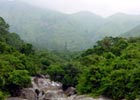 The
northern side of Lantau features this old fortress near a bay that once
curved around the pointed southern tip of tiny Chek Lap Kok. Atop a hill
overlooking this little harbor is an old fort built in 1871. The fort
was once a barrier that protected this town and bay from smugglers, pirates,
and scoundrels. To this day, the fort still stands strong with its six
old cannons that were the bulwark of the fort. The
northern side of Lantau features this old fortress near a bay that once
curved around the pointed southern tip of tiny Chek Lap Kok. Atop a hill
overlooking this little harbor is an old fort built in 1871. The fort
was once a barrier that protected this town and bay from smugglers, pirates,
and scoundrels. To this day, the fort still stands strong with its six
old cannons that were the bulwark of the fort.
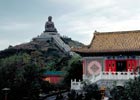 The
Po Lin Monastery, located above Lantau's central mountain range, is the
region's best known attraction. The world's largest outdoor bronze statue
of a seated Buddha (24 meters (79 ft) high) was built in this monastery.
The brightly painted red-orange and gold structure was completed in 1990.
Visitors to this temple are welcomed to browse the temple grounds and
those famished can treat themselves to a hearty vegetarian meal served
by resident monks in a huge dining hall. The
Po Lin Monastery, located above Lantau's central mountain range, is the
region's best known attraction. The world's largest outdoor bronze statue
of a seated Buddha (24 meters (79 ft) high) was built in this monastery.
The brightly painted red-orange and gold structure was completed in 1990.
Visitors to this temple are welcomed to browse the temple grounds and
those famished can treat themselves to a hearty vegetarian meal served
by resident monks in a huge dining hall.
Not far from the Po Lin Monastery is a tea plantation and teahouse serving
a local-style high tea known as the Lantau Tea Garden. The teahouse has
rooms for rent, barbecue facilities, and a free camping area.
Heading west from Po Lin is a superb walking path that crosses mountain
ridges, small canyons, and rushing streams en route to Lantau's Yin Hing
Monastery. The monastery is a haven opulent with traditional Buddhist
paintings and statues. Surrounding the monastery are mountains, farmland,
and the deep blue South China Sea.
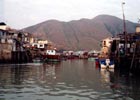 Lantau's
main town, Tai O, is located on the west coast and is the abode for aged-old
junks. The island's inhabitants are the Tanka boat people, who traditionally
lived on their boats near the shore but have now become semi-land dwellers.
A few of the larger junks have been transformed into three-story permanent
living structures. Lantau's
main town, Tai O, is located on the west coast and is the abode for aged-old
junks. The island's inhabitants are the Tanka boat people, who traditionally
lived on their boats near the shore but have now become semi-land dwellers.
A few of the larger junks have been transformed into three-story permanent
living structures.
Beyond Tai O Creek are feeble homes on stilts over parts of the creek
where the water rises during tide changes. A hand-raised drawbridge connects
the traffic from Tai O to Lantau. It was previously rope-drawn ferries
that carried people back and forth both destinations. Nevertheless, a
few old women still hang around the bridge landings to offer short boat
rides up and down the scenic canals.
A walk on both sides of the tidal creek offers a merit view of the boat
people and their unique way of life. Another location to observe these
sturdy old sea carriers is at Penny's Bay on Lantau's northern coast.
One of Hong Kong's best shipmaker is based there. Shipbuilders do not
only build junks, but also modern cruises.
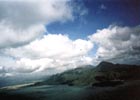 Anyone
who enjoys a peaceful and quiet retreat will definitely like the Lantau
Mountain Camp, at about 770 meter elevation of Sunset Peak (870 meter).
The camp provides 20 small stone houses, which were built before World
War II as a rest haven for the British colony's Christian missionaries
taking time off from their work in China. The houses are available for
rent by civilians who book in advance. Anyone
who enjoys a peaceful and quiet retreat will definitely like the Lantau
Mountain Camp, at about 770 meter elevation of Sunset Peak (870 meter).
The camp provides 20 small stone houses, which were built before World
War II as a rest haven for the British colony's Christian missionaries
taking time off from their work in China. The houses are available for
rent by civilians who book in advance.
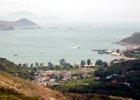 One
of the most popular beaches of Lantau is the Silver Mine Bay Beach. This
is the easiest accessible beach on the island, thus boosting its popularity.
A Silver Mine Bay Beach Resort is not far from the Silver Mine Bay ferry
landing. One
of the most popular beaches of Lantau is the Silver Mine Bay Beach. This
is the easiest accessible beach on the island, thus boosting its popularity.
A Silver Mine Bay Beach Resort is not far from the Silver Mine Bay ferry
landing.
The bus route from Silver Mine Bay to Tai O passes through Pui O Village,
a humdrum village whose main claim to fame is the Tong Fuk Provisions
Store. The store, nicknamed Charlie's, is a restaurant serving both Chinese
and Western cuisine. It also boasts of ample provisions of wine and cold
beer.
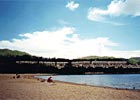 A
major real estate development area, the Discovery Bay is segregated from
the rest of Lantau Island. A housing and resort complex that includes
a golf course is available on this bay. Discovery Bay is one of the better
places to live in Hong Kong, as it is right by the beach and is an organized
community. It has its own rapid ferry system to and from Central on Hong
Kong Island. A
major real estate development area, the Discovery Bay is segregated from
the rest of Lantau Island. A housing and resort complex that includes
a golf course is available on this bay. Discovery Bay is one of the better
places to live in Hong Kong, as it is right by the beach and is an organized
community. It has its own rapid ferry system to and from Central on Hong
Kong Island.
|

